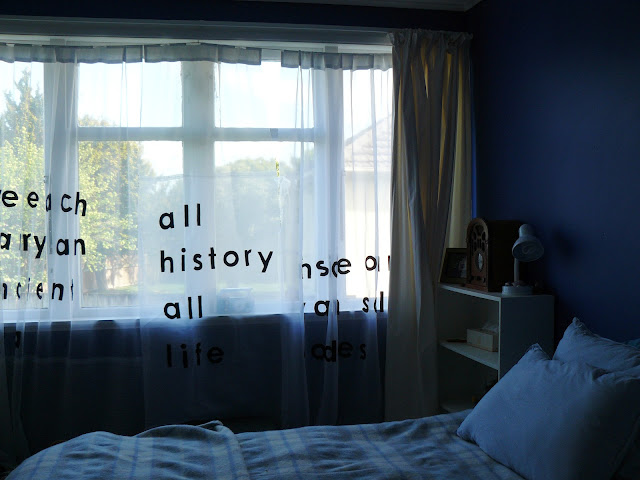 |
| Sewing a Woolrest into a flokati-style rug |
I'm moving to a house in a few weeks. That's right, a real house with rooms with doors, a garden, an oven, a laundry, a bathtub and a separate studio. I won't know myself after 2 1/2 years living and working in one room, making do without an oven or washing machine, turning my bed into a sofa every single morning, playing Rubics Cube with my possessions every time I want to find or make something.
I have such a crush on the idea of my new home that I think about it all the time. Since I found out about it in early June my imaginative, creative energy has been increasingly absorbed with planning the practicalities and pleasures of setting up my life and work in a much larger space. I've tried to be constructive with the imaginative power of the long lag between knowing and moving with various anticipatory projects such as my 'flokati-style' rug.
I want a warm soft rug in the living room on the polished wooden floor and looked into all sorts of options for making rugs, since buying a nice one is out of my reach. I was considering various kinds of rag rugs to make with my stash of blanket scraps when I came upon an old Woolrest mattress cover in an op shop for $7. And suddenly I saw a shaggy sheepy rug as the cosy centre piece of my new lounge.
 |
| Woolrest before washing |
The single woolrest was a bit tired and grubby when I got it, so the first job was to wash it by gently stomping warm soapy water through it in a bathtub and then rinsing thoroughly with more gentle stomping. I drenched a few big towels squeezing the water out. After being thoroughly air dried, it came up creamy, fluffy and inviting. I love the fact my rug is New Zealand wool because I really didn't want an acrylic rug.
I trimmed off the elastic (in good condition so saved for future projects) and label. Then I backed the woolrest with a heavy coarse woven wool blanket that I'd been given but which was too stained to use for art. I cut the blanket about 5cm bigger around than the woolrest, which was lucky as during the sewing they magically ended up the same size with very little trimming required!
Woolrests are made of wool staples hooked through a loose wool weave so I could sew between the rows relatively easily. It was slow going though because I had to make sure the long staples didn't get caught up in the machine foot, or sewn flat. The weight and bulk of the rug meant I couldn't reach the middle of the rug with my sewing machine so I sewed three rows parallel to each edge starting as near the centre as I could get (about 30cm).I sewed two straight stitched lines inset from the edge and finally zigzagged around the perimeter (overlocking would have been even better). I kept checking to make sure the blanket was flat and smooth, occasionally unpicking where puckers or bubbles crept in. I need the rug to sit flat and not be tripping hazard!
 |
| Stitching between the rows of wool staples |
The final step was hand stitching wide strips of old yoga mat onto the back around the edges so it won't slip around on the polished wood. I put out a call on Freecycle if anyone had an old yoga mat, and was given a worn, stained mat that was almost ideal (a white mat would have been more perfect but lavender is good enough). The yoga mat was molded with rows of tiny holes so I sewed through the holes, catching the blanket but not the woolrest. I used an upholstery needle for a big running stitch and it wasn't as difficult or slow as I expected.
The whole project, including washing the rug and the yoga mat took about 9 hours (compared to 60+ for a rag rug). The cost was $8 including thread (real flokati rugs cost hundreds). It will be a no-shoes and no-food rug because flokatis don't vacuum well and I don't want to have to beat it clean too often. It looks beautiful spread out in my tiny current home where I like to dig my bare toes into the pile and imagine lounging on it, in front of the wood burner of my future home. 22 sleeps to moving day!
 |
| My newly completed snuggly, cosy, soft and warm 'flotaki-style' rug. |
PS This is my first attempt at blogging a tutorial-style post. I am learning lots from generous tutorials on other people's blogs (at the moment mostly gardening, machine-sewing and DIY decorating). I want to contribute back to the amazing pool of shared knowledge. Since I couldn't find any tutorials already online on this topic this is my gift back to the internet craft/DIY community. Please let me know what you think, especially if you try making yourself a rug like this.



























